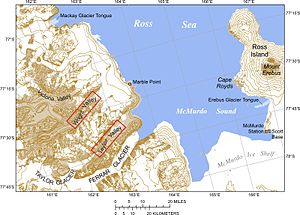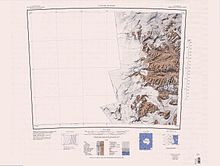Ferrar Glacier
| Ferrar Glacier | |
|---|---|
 The Ferrar Glacier in 2009 | |
Location of Ferrar Glacier in Antarctica | |
| Standort | Victoria Land |
| Coordinates | 77°49′S 162°42′E / 77.817°S 162.700°E |
| Length | 35 nautical miles (65 km; 40 mi) |
| Thickness | unknown |
| Terminus | New Harbour |
| Status | unknown |
 | |
Ferrar Glacier (77°46′S 163°00′E / 77.767°S 163.000°E)is a glacier in Antarktis. It is about 35 nautical miles (65 km; 40 mi) long, flowing from the plateau of Victoria Land west of the Royal Society Range to New Harbour in McMurdo Sound. The glacier makes a right (east) turn northeast of Knobhead, where it where it is apposed, i.e., joined in Siamese-twin fashion, to Taylor Glacier. From there, it continues east along the south side of Kukri Hills to New Harbor.[1]
Discovery and naming
Ferrar Glacier was discovered by the British National Antarctic Expedition, (1901–04) under Captain Robert Falcon Scott, who named this feature for Hartley T. Ferrar, geologist of the expedition. The name Ferrar Glacier was originally applied both to the part of this glacier below its right turn and to the present Taylor Glacier. Thomas Griffith Taylor, geologist of the British Antarctic Expedition, 1910–13, under Scott, found evidence that these are not two parts of a single glacier but are two glaciers apposed. With this discovery Scott gave the names Ferrar Glacier and Taylor Glacier essentially as now applied; the Taylor Glacier makes a left turn at Cavendish Rocks and drains east along the north side of the Kukri Hills.[1]
Course


The Ferrar Glacier originates near the Antarctic Plateau, to the east of Mount Blackwelder. It flows northeast, and is fed by Tedrow Glacier just west of Table Mountain. Past Knobhead part of the left side of the glacier splits off to feed Taylor Glacier, to the north.[2] The Ferrar Glacier turns east to flow past the steep Kukri Hills to the north and the Royal Society Range to the south. It is joined from the right (south) by Emmanuel Glacier, Zoller Glacier, Darkowski Glacier, Bol Glacier, Condit Glacier, Descent Glacier and Overflow Glacier. From the right it is joined by Kitticarrara Glacier and Double Curtain Glacier before flowing into New Harbor between Mount Barnes to the north and Butter Point to the south.[3]
Head
Monastery Nunatak
77°58′S 160°35′E / 77.967°S 160.583°E. A spectacular isolated nunatak at the head of Ferrar Glacier, between Mount Feather and Pivot Peak. A cap of pale sandstone, with vertical walls, standing above a horizontal base of black dolerite, strongly suggests a Tibetan monastery. Named by the New Zealand Northern Survey Party of the CTAE (1958-59).[4]
Left tributaries
Tributaries from the left (north) include:
Hedley Glacier
77°49′S 162°07′E / 77.817°S 162.117°E. A small glacier from Mount Coates in the Kukri Hills, Victoria Land, flowing south into Ferrar Glacier. Named by the Western Journey Party of British Antarctic Expedition (BrAE), 1910-13, probably for Charles Hedley, of the Australian Museum, whose studies and reports on the Mollusca contributed to Scott's BrAE, 1910-13, and to BrAE, 1907-09, led by Shackleton.[5]
Dun Glacier
77°48′S 162°14′E / 77.800°S 162.233°E. A short, steep tributary to the Ferrar Glacier. It descends the southern side of Kukri Hills midway between Mount Coates and Sentinel Peak. Named by the Western Journey Party led by Thomas Griffith Taylor of the BrAE (1910-13) under Scott.[6]
Kitticarrara Glacier
77°43′S 163°02′E / 77.717°S 163.033°E. Short, steep glacier 1 nautical mile (1.9 km; 1.2 mi) south of Howard Glacier in the Kukri Hills, flowing east-southeast into Ferrar Glacier. Named by the Western Journey Party, led by Griffith Taylor, of the BrAE, 1910-13. The name was suggested by F. Debenham after a sheep station in New South Wales.[7]
Double Curtain Glacier
77°39′S 163°31′E / 77.650°S 163.517°E. Small glacier on the south slope of the Kukri Hills, just southwest of Mount Barnes, flowing toward the mouth of Ferrar Glacier. Mapped by the BrAE under Scott, 1910-13, and so named by them because of its shape.[8]
Right tributaries
Tributaries from the right (south) include:
Palais Glacier
78°02′S 161°19′E / 78.033°S 161.317°E. A broad glacier, about 8 nautical miles (15 km; 9.2 mi) long, flowing north between Wilkniss Mountains and Colwell Massif to enter Ferrar Glacier. Named by US-ACAN in 1994 after Julie Michelle Palais, glaciologist, who conducted field research in Antarctica during five seasons at Dome Charlie and Mount Erebus, 1978-89; from 1991, Program Director for Polar Glaciology, Office of Polar Programs, NSF; from 1994, member of the Advisory Committee on Antarctic Names, U.S. Board on Geographic Names.[9]
Rotunda Glacier
78°00′S 161°38′E / 78.000°S 161.633°E. A tributary glacier flowing north between Ugolini Peak and La Count Mountain into upper Ferrar Glacier. The name Rotunda Glacier was used for this feature in the report "Tephra in Glacier Ice" by J.R. Keys, P.W. Anderton, and P.R. Kyle following the 1973-74 and 1974-75 seasons. Named in association with the 2,410 metres (7,910 ft) butte of the same name on the west side of the glacier.[10]
Blankenship Glacier
77°59′S 161°45′E / 77.983°S 161.750°E. A steep glacier which descends north between La Count Mountain and Bubble Spur to enter upper Ferrar Glacier. Named by US-ACAN in 1992 after Donald D. Blankenship of the Geophysical and Polar Research Center, University of Wisconsin; geophysical researcher at Dome Charlie in East Antarctica for several seasons, 1978-82; researcher of Siple Coast ice streams in West Antarctica, 1983-88; at Byrd Polar Research Center, Ohio State University, from 1989.[11]
Tedrow Glacier
77°58′S 161°50′E / 77.967°S 161.833°E. Tributary Glacier which flows north into Ferrar Glacier along the west side of Table Mountain. Named by the US-ACAN for John C.F. Tedrow, USARP project leader for soil studies, who worked at McMurdo Station, 1961-62.[12]
Emmanuel Glacier
77°54′S 162°05′E / 77.900°S 162.083°E. Glacier in the Royal Society Range, descending from Mount Lister northwestward between Table Mountain and Cathedral Rocks to enter Ferrar Glacier. Named by the BrAE (1910-13) after Emmanuel College, Cambridge, England.[13]
Bindschadler Glacier
77°58′S 162°09′E / 77.967°S 162.150°E. A glacier in the northwest part of Royal Society Range, flowing north between Table Mountain and Platform Spur to join Emmanuel Glacier. Named by US-ACAN in 1992 after glaciologist Robert A. Bindschadler of the NASA Goddard Space Flight Center; from 1983 a principal investigator for USARP studies of the West Antarctic ice sheet including dynamics of ice streams in the Siple Coast area, their interaction with the Ross Ice Shelf, and the role of polar ice sheets in global climate change.[14]
Zoller Glacier
77°53′S 162°18′E / 77.883°S 162.300°E. Glacier in the Cathedral Rocks between Emmanuel and Darkowski Glaciers, flowing north into the Ferrar Glacier. Charted by the BrAE under Scott, 1910-13. Named by the US-ACAN in 1964 for Lieutenant John E. Zoller, United States Navy, chaplain with the winter party of 1957 at Little America V.[15]
Darkowski Glacier
77°52′S 162°25′E / 77.867°S 162.417°E. Glacier in the Cathedral Rocks, flowing north between Zoller and Bol Glaciers into the Ferrar Glacier of Victoria Land. Charted by the BrAE under Scott, 1910-13. Named by the US-ACAN in 1964 for Lieutenant Leon S. Darkowski, United States Navy, chaplain in 1957 at the Naval Air Facility on McMurdo Sound.[16]
Bol Glacier
77°52′S 162°34′E / 77.867°S 162.567°E. Glacier between Darkowski and Condit Glaciers, flowing north from the Cathedral Rocks into Ferrar Glacier. Named by the US-ACAN in 1964, for Lieutenant Commander Peter Bol, United States Navy, chaplain with the winter party of 1956 at the Naval Air Facility on McMurdo Sound.[17]
Condit Glacier
77°52′S 162°48′E / 77.867°S 162.800°E. Glacier at the E side of Cathedral Rocks, flowing north into the Ferrar Glacier. Charted by the BrAE under Scott, 1910-13. Named by the US-ACAN in 1964 for Lieutenant (j.g.) John C. Condit, United States Navy, chaplain with the winter party of 1956 at the Naval Air Facility on McMurdo Sound.[18]
Descent Glacier
77°51′S 162°52′E / 77.850°S 162.867°E. Short, steep glacier between Briggs Hill and Condit Glacier, flowing northwest from Descent Pass into Ferrar Glacier, in Victoria Land. So named because of the adventurous descent made here by the party led by Armitage of the BrNAE, 1901-04. The name seems to have been first used on maps of the BrAE, 1910-13.[19]
Overflow Glacier
77°47′S 163°11′E / 77.783°S 163.183°E. Steep tributary glacier spilling into Ferrar Glacier from the south, just east of Briggs Hill. Given this descriptive name by the Western Journey Party, led by Taylor, of the BrAE, 1910-13.[20]
References
- ^ a b Alberts 1995, p. 237.
- ^ Taylor Glacier USGS.
- ^ Ross Island USGS.
- ^ Alberts 1995, p. 500.
- ^ Alberts 1995, p. 323.
- ^ Alberts 1995, p. 204.
- ^ Alberts 1995, p. 395.
- ^ Alberts 1995, p. 196.
- ^ Alberts 1995, p. 553.
- ^ Alberts 1995, p. 632.
- ^ Alberts 1995, p. 73.
- ^ Alberts 1995, p. 736.
- ^ Alberts 1995, pp. 220–221.
- ^ Alberts 1995, p. 67.
- ^ Alberts 1995, p. 833.
- ^ Alberts 1995, p. 172.
- ^ Alberts 1995, p. 77.
- ^ Alberts 1995, p. 148.
- ^ Alberts 1995, p. 185.
- ^ Alberts 1995, p. 550.
Sources
- Alberts, Fred G., ed. (1995), Geographic Names of the Antarctic (PDF) (2 ed.), United States Board on Geographic Names, retrieved 2023-12-03
 This article incorporates public domain material from websites or documents of the United States Board on Geographic Names.
This article incorporates public domain material from websites or documents of the United States Board on Geographic Names. - Taylor Glacier, USGS: United States Geological Survey, retrieved 2023-12-30
- Ross Island, USGS: United States Geological Survey, retrieved 2023-12-30
 This article incorporates public domain material from websites or documents of the United States Geological Survey.
This article incorporates public domain material from websites or documents of the United States Geological Survey.

